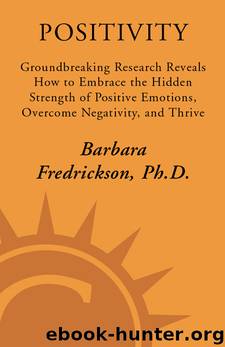Positivity by Barbara Fredrickson

Author:Barbara Fredrickson [Fredrickson, Barbara]
Language: eng
Format: epub
ISBN: 978-0-307-45219-1
Publisher: Crown Publishing Group
Published: 2009-11-06T16:00:00+00:00
More Data, More Support
My research doesn't stand alone in supporting Losada's math. It gets even better. Take, for instance, the work of John Gottman, the world's leading expert on the science of marriage.19 Gottman has devoted his career to studying the emotional dynamics in married couples, pinpointing patterns that make marriages mutually satisfying and enduring, as well as those that begin cascades toward divorce. Early in my career, I got to know Gottman's research program well. I even collaborated on a small piece of it in the early 1990s, when I was a postdoctoral fellow at UC Berkeley20
Gottman's signature way to gather data on marriages was to invite couples to visit his laboratory. Whereas Losada's laboratory felt like a boardroom, Gottman's felt like a living room. Here he'd ask couples to get comfortable and talk with each other as they would at home. Eventually, he'd coax them to talk about the hard stuff— any issue that currently caused them considerable disagreement. For some couples the discussion centered on money, for others it was how to raise their kids. For still others, it was how to deal with extended family. Each couple picked their own “hot” issue.
Like the very best emotion researchers, Gottman collected a wide range of data. He used tiny sensors to measure people's heart rates, sweat gland activity, and other physiological changes during the conversations. He used carefully placed video cameras to unobtrusively capture the verbal and nonverbal communications between the marriage partners. He complemented these with a wide range of surveys from each person. And, ultimately, he stayed in touch with these couples and tracked which marriages lived on “happily ever after” and which ones eventually dissolved. Surveying this mass of data, Gottman developed several ways to compute the positivity ratio of a marriage. Sometimes, like Losada, he had trained coders classify everything that partners said to each other. At other times he had his coders consider observable gestures and facial expressions as well.
Gottman eventually divided the marriages into two groups. One group was made up of marriages that lasted and that both partners found to be satisfying. I call those flourishing marriages. The other group was made up of marriages that had fallen apart. The partners had become dissatisfied, estranged, separated, or divorced. At best, these marriages were languishing; at worst, they were total failures. What he found was remarkable. Among flourishing marriages, positivity ratios were about 5 to 1. By sharp contrast, languishing and failed marriages had positivity ratios lower than 1 to 1. Although Gottman was not working to test Losada's math, his data nonetheless supports it.
But wait, there's more. This time the evidence comes from a sci entist named Robert Schwartz. A practicing clinical psychologist, Schwartz had developed his own mathematical model, rooted in Boolean algebra, to suggest that optimal positivity ratios are about 4 to 1. He compares these to “normal” positivity ratios— the ones most people have— which are about 2 to 1. By contrast, he suggests that pathological positivity ratios— for example, those of depressed people— are lower than 1 to 1.
Download
This site does not store any files on its server. We only index and link to content provided by other sites. Please contact the content providers to delete copyright contents if any and email us, we'll remove relevant links or contents immediately.
Should I Stay or Should I Go? by Ramani Durvasula(6799)
Why We Sleep: Unlocking the Power of Sleep and Dreams by Matthew Walker(5656)
Fear by Osho(4094)
Flow by Mihaly Csikszentmihalyi(4061)
Rising Strong by Brene Brown(3787)
Why We Sleep by Matthew Walker(3781)
Too Much and Not the Mood by Durga Chew-Bose(3700)
How to Change Your Mind by Michael Pollan(3686)
The Hacking of the American Mind by Robert H. Lustig(3588)
Lost Connections by Johann Hari(3460)
He's Just Not That Into You by Greg Behrendt & Liz Tuccillo(3309)
Evolve Your Brain by Joe Dispenza(3059)
What If This Were Enough? by Heather Havrilesky(2947)
Resisting Happiness by Matthew Kelly(2891)
Crazy Is My Superpower by A.J. Mendez Brooks(2866)
The Courage to Be Disliked by Ichiro Kishimi & Fumitake Koga(2809)
The Book of Human Emotions by Tiffany Watt Smith(2779)
Descartes' Error by Antonio Damasio(2744)
In Cold Blood by Truman Capote(2692)
